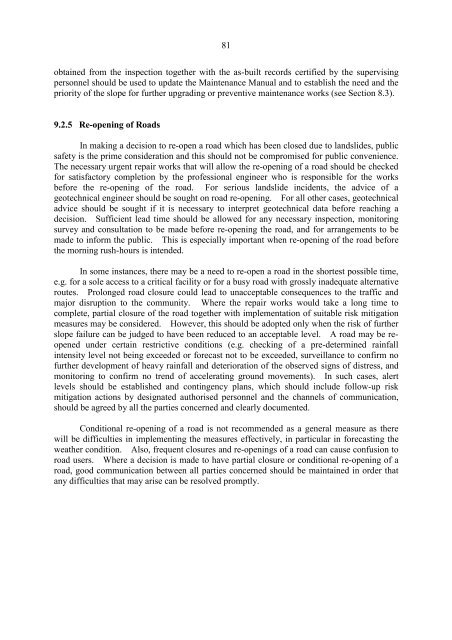Highway Slope Manual
Highway Slope Manual
Highway Slope Manual
Create successful ePaper yourself
Turn your PDF publications into a flip-book with our unique Google optimized e-Paper software.
81<br />
obtained from the inspection together with the as-built records certified by the supervising<br />
personnel should be used to update the Maintenance <strong>Manual</strong> and to establish the need and the<br />
priority of the slope for further upgrading or preventive maintenance works (see Section 8.).<br />
9.2. Reopening o Roads<br />
In making a decision to re-open a road which has been closed due to landslides, public<br />
safety is the prime consideration and this should not be compromised for public convenience.<br />
The necessary urgent repair works that will allow the re-opening of a road should be checked<br />
for satisfactory completion by the professional engineer who is responsible for the works<br />
before the re-opening of the road. For serious landslide incidents, the advice of a<br />
geotechnical engineer should be sought on road re-opening. For all other cases, geotechnical<br />
advice should be sought if it is necessary to interpret geotechnical data before reaching a<br />
decision. Sufficient lead time should be allowed for any necessary inspection, monitoring<br />
survey and consultation to be made before re-opening the road, and for arrangements to be<br />
made to inform the public. This is especially important when re-opening of the road before<br />
the morning rush-hours is intended.<br />
In some instances, there may be a need to re-open a road in the shortest possible time,<br />
e.g. for a sole access to a critical facility or for a busy road with grossly inadequate alternative<br />
routes. Prolonged road closure could lead to unacceptable consequences to the traffic and<br />
major disruption to the community. Where the repair works would take a long time to<br />
complete, partial closure of the road together with implementation of suitable risk mitigation<br />
measures may be considered. However, this should be adopted only when the risk of further<br />
slope failure can be judged to have been reduced to an acceptable level. A road may be reopened<br />
under certain restrictive conditions (e.g. checking of a pre-determined rainfall<br />
intensity level not being exceeded or forecast not to be exceeded, surveillance to confirm no<br />
further development of heavy rainfall and deterioration of the observed signs of distress, and<br />
monitoring to confirm no trend of accelerating ground movements). In such cases, alert<br />
levels should be established and contingency plans, which should include follow-up risk<br />
mitigation actions by designated authorised personnel and the channels of communication,<br />
should be agreed by all the parties concerned and clearly documented.<br />
Conditional re-opening of a road is not recommended as a general measure as there<br />
will be difficulties in implementing the measures effectively, in particular in forecasting the<br />
weather condition. Also, frequent closures and re-openings of a road can cause confusion to<br />
road users. Where a decision is made to have partial closure or conditional re-opening of a<br />
road, good communication between all parties concerned should be maintained in order that<br />
any difficulties that may arise can be resolved promptly.

















